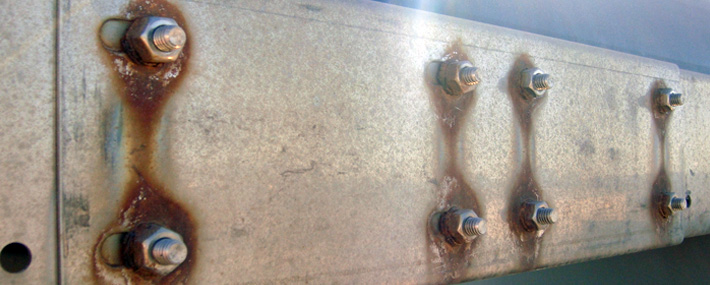When specifying products for use within harsh environments, choosing the correct materials is vital. For example, in offshore oil and gas installations, equipment experiences exposure to high levels of seawater and salt-spray, which are highly corrosive due to the dissolved chlorides within. Offshore installations are not the only projects that experience harsh, corrosive environments, other corrosives that affect a wide range of industries include: chlorine, ammonia and hydrochloric acid.
In May we reviewed the effects of galvanic-corrosion between two dissimilar metals, in that example we explored the use of stainless steel cleats with galvanised steel support structures. Corrosion can take many different forms and choosing the correct materials and finishes is key to minimising its effects. We have outlined common corrosion control methods, explaining how and where they should be implemented.
Choosing materials based on their galvanic characteristics
Different metals have different electrode potentials, therefore when two different metals are electrically connected in the presence of an electrolyte, such as seawater, the more active metal will become anodic leading to loss of electrons and increasing oxidisation in a process known as galvanic-corrosion.
Metals and alloys are ranked in order of noble to active, in what is called the galvanic series. A more noble metal, such as stainless steel, will have much better corrosion-resistance than a more active metal such as cast iron.
 Galvanic Series of Metals
Galvanic Series of Metals
Galvanic corrosion can be controlled and minimized by selecting metals in similar positions within the galvanic series. A more active metal can also be used as a sacrificial anode, attracting corrosion in order to protect the more noble metal from corrosive attack. Alternatively, depending on the installation, a cleat separation washer can be installed between the dissimilar metals increasing the distance between each metal and removing the electrical and physical contact points, critical to causing corrosion.
Passivation
During manufacturing, certain metals form a layer of metal oxide on the surface in a process known as passivation. Although the process occurs naturally, it can be enhanced through chemical passivation treatments and anodising. The layer protects against corrosion as it is tightly bound to the surface, preventing further penetration of oxygen and corrosive molecules.
The most common examples include aluminium and stainless steel. Usually, if these metals are damaged the layer reforms quickly, however this process is not without its faults. Pitting corrosion can occur in aluminium when chloride ions interfere with the reforming process and high chromium carbides can affect welded stainless steel.
If the products are properly selected for the intended application, passivated metals can provide high levels of corrosion-resistance. This is why stainless steel cleats are the preferred product within offshore installations.
Protective Finishes and Coatings
Various protective coatings can be applied to metals to help shield metallic surfaces from the surrounding environment, including epoxy power coating, oven-baked enamel, hot-dipped galvanisation and PVC-type coatings. Care must be taken when installing products with these coatings as any damage during installation and fitting, drilling and cutting etc. must be re-protected to ensure the integrity of the rest of the coating.
Hot-dipped galvanised products offer two forms of protection as the zinc coating protects the surface of the steel and becomes a sacrificial anode if damaged.
Non-metallic components
In highly corrosive environments, where metals are not suitable due to high levels of corrosion, non-metallic products are commonly being specified as an alternative. It is important to remember that plastics are not completely impervious to chemicals and often suffer from UV exposure, which should be taken into consideration when specifying project materials.
The possibility of corrosion may not be at the forefront of material specifications and in times of economic hardship, may be over looked. However, with the World Corrosion Organisation estimating the annual cost of corrosion, throughout all industries, at $2.2 trillion, it truly is a global issue. We believe any short-term savings made from overlooking the extensive effects of corrosion will be more costly in the future and the figure from the WCO backs this up.
If you are concerned about potentially corrosive environments affecting products you may be specifying, we are able to offer expert advice on the best product to suit your specific requirement.
Have you had any experience with corrosion and would like to share your experiences then please leave a comment below. Learn more about our offer of electrical lugs.
If you found this article helpful or interesting, please share it!















